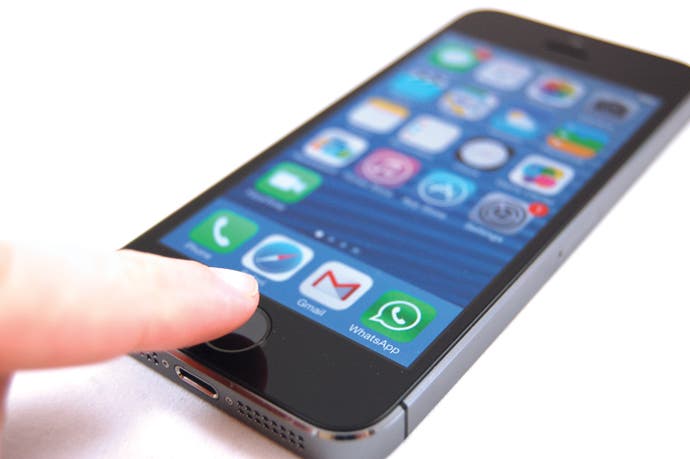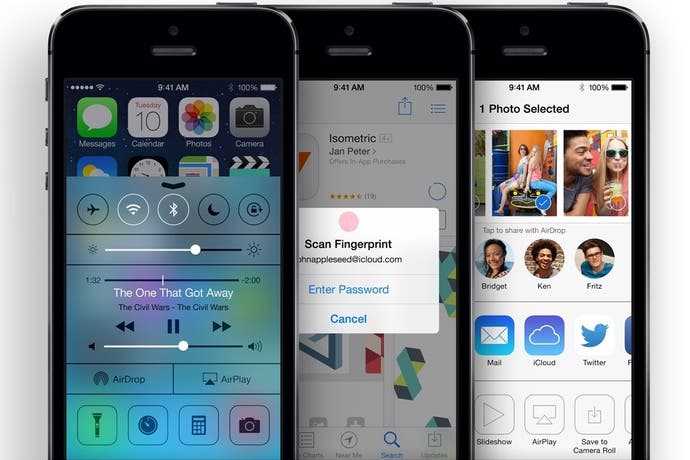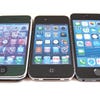iPhone 5S review
Pocket rocket.
Dogged by controversy over the shortcomings of iOS 6 - and, in particular, the woeful state of the maps app at launch - the iPhone 5 didn't get much of a break during its initial weeks on the market. A solid device with excellent games performance and a logical refactoring of the screen, the phone was clearly another quality product from Apple, but game frame-rates and OS fluidity aside, it was difficult to see much of a reason to upgrade as enhancements to basic functionality weren't quite compelling enough. The iPhone 5S puts things to rights.
This review has been a long time coming - the insane schedule of next-gen console and GPU press events in addition to our usual workload combined to shunt back our appraisal of this new Apple offering, but on the flipside, the opportunity to take it on as our daily runner across the duration gives us a broader, wider view of the 5S from the perspective of a new owner with several weeks experience of the device under our belts - a valuable experience in addition to 'just' reviewing it.
On first glance, it's safe to say that there isn't much to differentiate it from the outgoing iPhone 5 - an observation you can level at any of the "S" devices Apple has produced. The chassis is virtually identical, the screen is the same, and the weight is like-for-like - there's still that almost unnatural lightness to the device that almost makes it feel insubstantial compared to the reassuring presence of the 4S. The only major difference on the front side comes from the home button, housing the new Touch ID fingerprint sensor. While the four-digit PIN remains as a security feature if you want to use it, the way to access a locked phone is now to press the finger of your choice against the sensor and wait for around a second for it to unlock.
The calibration sequence is pretty neat, with the technology taking several samples of each finger, along with a separate set of metrics from the same finger held at an angle. The result is that Touch ID works fairly well - it's faster and easier to use than the PIN entry system, but it's not foolproof. Over the course of the weeks, we'd estimate success rate at about 85 to 90 per cent. Positioning of the finger is crucial (we'd suspect that this is the case especially for those with large digits) and on the odd occasion we find that the sensor is completely unresponsive, requiring entry of the PIN.
Some may also have security concerns about the iPhone 5S too. The device remains a fingerprint magnet - especially so on the Touch ID sensor itself. So there is the irony of the key to the phone's security being immediately and obviously visible on the input itself. The system has already been cracked, it's just a case of whether the methodology involved can easily be copied by common thieves. We'd hazard a guess that the system is probably secure enough for now, but remain a bit worried about its long-term prospects.
However, the arrival of Touch ID in itself clearly suggests that Apple has realised that an improved screen and boosted specs are not enough in their own right to sell a new piece of hardware. The A5 processor in the iPhone 4S may no longer be the state of the art, but the point is that it handles all the major functions you'd want from a smartphone and still does so very well indeed. The 5S features a number of remarkable technological improvements, but they are just a small part of the overall package. Where it matters is in improved functionality - and that's what makes the 5S a winner.
Touch ID is matched by the best overall smartphone camera we've used. While there remains plenty of controversy about the merits of Apple's offering up against the 41-megapixel Nokia Lumia 1020, the fact is that the 5S camera is a masterpiece of form factor and functionality, delivering great results without compromising the size and shape of the device. Low-light performance is good - thanks in no small part to a CMOS sensor with larger pixels - but the new dual-colour flash also lives up to Apple's claims of delivering more vibrant flash photography in difficult conditions.
In operation, what we really liked about the phone's camera mode is the sheer speed and response. Point, click to shoot, and you have instant results with zero lag - fast enough for Apple to have introduced a 10fps burst photography mode, good for up to 999 shots. This remains extremely fast too - suggesting that photos are recorded to RAM before being spooled out onto the device's solid state storage. Video is also improved significantly via the inclusion of 120fps slow-motion 720p imagery. We enjoyed the 90fps slow-mo found in the Xiaomi MI2 but found that it would drop frames in low-light conditions. In our recent trip to Nvidia's G-Sync event in Montreal, we found that the 120fps mode worked extremely well, even in low-light conditions.
"Touch ID isn't perfect, but its failure rate is fairly small and it's more convenient than entering a four-digit pin every time you want to gain access to your phone."

Another interesting area of development is the inclusion of the new M7 co-processor - essentially a new piece of silicon that provides hardware acceleration for the handling of sensor inputs from the accelerometer, compass and gyroscope. This has power-saving implications - the CPU can now remain in a low-power state when you're on a run, for example - but it's always active, so apps using the new CoreMotion API can track your activities even if they are not active.
In the short term, expect to see plenty of fitness-related applications that make use of the M7, but over the longer term we expect to see far more subtle, clever uses of the technology. Are you walking? Are you driving? Are you on public transport? The OS and apps will be able to contextualise functionality based on what you're doing, where you're going and how quickly you'll get there, and it'll be able to do so without invoking any appreciable CPU power, thus preserving battery life.
Of course, while Apple has prioritised functionality, the iPhone 5S does include the now mandatory 2x boost to performance - no mean feat considering that the dual-core A6 with its custom "Swift" cores delivered excellent CPU performance for their time. The new A7 sees Swift replaced by Cyclone, a revised 64-bit architecture. What's impressive here is that we're still looking at a dual-core set-up, and while various benchmarks will produce varying results, A7 does provide an appreciable boost to performance. The move to 64-bit can only explain some of this improvement - in truth, we believe that Apple is playing the long game here, building up 64-bit support in the short term so there is no jarring transition from one CPU generation to the next. Certainly, the extra memory-addressing advantages 64-bit offers aren't massive relevant in the here and now - the iPhone 5S still ships with just 1GB of onboard RAM.
"How far we've come. While the iPhone 4/4S chassis still holds up as a quality design, the older 2G/3G/3GS design now feels like a relic from another age."
GPU-wise, we see the arrival of some genuinely impressive tech with the debut of PowerVR's sixth-generation GPU, codenamed Rogue. Here we have the G6430 variant, possessing four cores. The architecture is scalable, ramping up to around one teraflop in power, but in the here and now we have a piece of silicon that's best-in-class, over twice as powerful as the A6 and marginally faster than the Adreno 330 in the new Nexus 5. What's impressive is that Apple has delivered this level of performance in the comparatively miniscule iPhone 5 chassis, whereas top-end performance in this form factor simply isn't available in the Android space - we need to look at larger devices like the Nexus 4 or the Galaxy S4 for big performance.
The net result of the CPU and GPU upgrades is a highly worthwhile boost in gaming power. iPhone 5S not only features top-of-the-line processing capabilities but it is married to a small screen with a relatively low resolution. While higher-resolution screens are undoubtedly an option going forward, Apple's definition of what constitutes a "Retina" display still hands in pleasing results in the here and now, and fewer pixels to generate means higher frame-rates.
To quantify that, our "go to" game for resource-hogging over the generations has been Gameloft's Halo/Crysis hybrid, NOVA 3. When we tested it on a Tegra 3 tablet, we got single-digit frame-rates. The experience was bearable on iPad 2/iPad mini, but definitely sub-optimal on the 4S, which features a downclocked version of the same A5 processor. We saw a much higher level of NOVA 3 performance on the iPhone 5, but the 5S hands in a fluid, almost faultless 60fps experience. Graphically adventurous titles like The Cave, Horn and XCOM: Enemy Unknown also gave extremely smooth frame-rates - not 60fps, but very, very close to it.
"Games generally run smoother, but a lot of titles feature frame-rate locks, essentially limiting the performance of the most powerful iPhone yet produced."
However, you can't bank on 60Hz nirvana with every title. Infinity Blade 2 seems to be locked to a frame-rate in the mid-30s no matter what hardware you throw at it, Sonic the Hedgehog 4 (Episode 2) struggled to consistently update at anything like the console versions, while our new resource-hogging stress-test - Gameloft's Asphalt 8 - ran well under but still stuttered and juddered at seemingly random points. We were a little disappointed by Real Racing 3 performance too - again, a frame-rate lock appears to be in place where 60fps gameplay would have made a real difference.
Of course, the key game for assessing the iPhone 5S is clearly Epic's Infinity Blade 3, where the developers are gradually deploying more Unreal Engine 3 features as mobile hardware becomes more powerful. Particularly in its outdoor scenes, the quality of the artwork and the effects are simply gorgeous, though the impact is diminished somewhat on the indoor scenes. Here we don't see a frame-rate boost, but we do get to see the GPU used for additional bling, and the results are often quite beautiful. As with the iPhone 5 though, we do wonder just how many titles will actually make use of this additional processing power.
Apple clearly has faith in the new A7 architecture. The new iPad Air doesn't have an A7X variant this time around - it's exactly the same chip with some modifications made to clock-speed and power management. Bearing in mind the huge gulf in resolution between the 5S and the 9.7-inch Apple tablets, we're extremely curious to see if gaming frame-rates are a leap beyond what we're seeing here.
"The 5S uses the same processor as the iPad Air running at a slightly slower clock - but with far fewer pixels to service on-screen, its frame-rates are noticeably better."
| iPhone 5S | iPad Air | iPhone 5/5C | iPhone 4S | |
|---|---|---|---|---|
| Geekbench 3 (single/multi-core) | 1417/2559 | 1482/2698 | 721/1297 | 217/412 |
| Sunspider 0.9.1 (Java) | 416.3ms | 405.2ms | 993.5ms | 1800.3ms |
| GFX Bench 2.7 T-Rex HD (on/offscreen) | 36fps/25fps | 20fps/25fps | 13fps/7fps | 3fps/6fps |
| GFX Bench 2.7 Egypt HD (on/offscreen) | 53fps/57fps | 48fps/63fps | 37fps/30fps | 12fps/21fps |
| 3DMark Ice Storm Unlimited | 13871 | 14842 | 5655 | 2181 |
Apple iPhone 5S: the Digital Foundry verdict
The jump from Apple's A4 to A5 architecture was vast - a move from single to dual-core processing, and a monumental leap in GPU performance that opened the door to - what was at the time - best-in-class 3D gaming. At a stroke, the most obvious performance limitations of the original iPad and the iPhone 4 were wiped out, and what we had was a piece of technology more than good enough to handle almost any everyday task while handing in a great gameplay experience. After that, the revised screen and 2x performance boost that we had with the A6 and the iPhone 5 was never going to have quite the same impact, and we couldn't help but wonder whether the 5S would be nothing more than another iterative improvement.
With the arrival of the 64-bit A7 in the iPhone 5S, the doubling of performance over its predecessor is now far more meaningful, and we finally have an iOS device that offers a comprehensive, almost night-and-day difference over the trusty 4S, with an improved level of fluidity in browsing and apps. It's an iterative improvement, iOS 7 has its critics, but we've found it to be robust, solid and attractive.
However, what makes the 5S worth its ticket price is the approach to real-life usage, in particular the focus on delivering excellent camera performance with a wealth of features. For us, after calls, and browsing, it's the camera that is the most important element of a smartphone and the results here are excellent. There also seems to be much of a push from Apple in getting more productivity out of the device too - hence the recent move in making its Office-style apps free to download.
Overall, the 5S is the most powerful compact smartphone we've tested and, as such, highly recommended. However, up against the Nexus 5, HTC One and the Galaxy S4, it's clear that the larger five-inch phones do provide something Apple doesn't - expansive real estate and true 1080p resolution, making them especially ideal for media consumption on the go. So as good as it is, the iPhone 5S isn't the default solution for everyone - the market has diversified too much for that - but it's still a hell of a good product.












